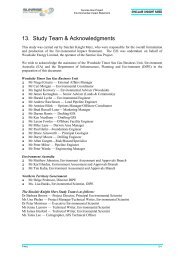Appendix D Terrestrial and Aquatic Biodiversity - Environment ...
Appendix D Terrestrial and Aquatic Biodiversity - Environment ...
Appendix D Terrestrial and Aquatic Biodiversity - Environment ...
You also want an ePaper? Increase the reach of your titles
YUMPU automatically turns print PDFs into web optimized ePapers that Google loves.
Coastal Port Facilities<br />
The coastal port facilities is an area which is targeted for limited clearing (17 ha). The main purpose of<br />
vegetation assessment for this zone has focused on refining existing mapping to NVIS level V at<br />
approximately 1:30,000 scale using aerial imagery <strong>and</strong> ground-truthing. As the total potential disturbance<br />
area is small (compared to the MLA areas), <strong>and</strong> is already particularly disturbed <strong>and</strong> weed infested, the level<br />
of vegetation assessment has been confined to characterising the habitat only. Further assessment will be<br />
required to determine the scope of weed management issues.<br />
Table 2: Summary of vegetation mapping <strong>and</strong> surveys undertaken for this report<br />
Proposed Zone of<br />
Impact<br />
MLA areas<br />
Haul Road<br />
Corridor<br />
Coastal Port<br />
Facilities<br />
Purpose <strong>and</strong> Level of Vegetation Mapping <strong>and</strong> Survey Applied<br />
Purpose: Fine scale description of the vegetation types <strong>and</strong> identification of notable plant<br />
species (threatened, rare or restricted in range) <strong>and</strong> assemblages which require specific<br />
management attention.<br />
Level of mapping <strong>and</strong> survey: Vegetation mapping at ~1:25,000 scale NVIS level V.<br />
Aerial photography: 25cm x 25cm cell size (12 th July 2008)<br />
Extent: 36km 2<br />
Number of survey sites: 107 (62 full reference, 45 check sites)<br />
Timing of surveys: October 2010, May 2011 <strong>and</strong> February 2012<br />
Purpose: Broad scale ground-truthing of the existing l<strong>and</strong> system mapping at 1:250,000<br />
scale; <strong>and</strong><br />
Habitat <strong>and</strong> identification, delineation <strong>and</strong> characterisation of high value habitat types,<br />
namely: rainforest, monsoonal vine thicket, billabongs, rocky ridges or escapements <strong>and</strong><br />
riparian habits which may be sensitive to disturbance <strong>and</strong> require specific management<br />
attention.<br />
Level of mapping <strong>and</strong> survey: Data collection to ground-truth existing l<strong>and</strong> system<br />
mapping at 1:250,000 scale using helicopter survey points (i.e. rapid assessment) <strong>and</strong><br />
several detailed vegetation assessments at fauna survey locations (5 survey locations<br />
totalling 21 survey sites) which aligned to NVIS Level V documenting the dominant species<br />
(contributing >5% cover) within three strata.<br />
Notable habitat was targeted along the haul road <strong>and</strong> surveyed at a level detailed enough to<br />
determine respective habitat quality.<br />
Aerial photography: Bing Maps (ESRI basemap layer) <strong>and</strong> Google Earth Pro were viewed<br />
at a scale between 1:25,000 <strong>and</strong> 1:50,000.<br />
Extent: Total length of 164km <strong>and</strong> width of 6km (984km 2 )<br />
Number of survey sites: 41 outcrop, 112 waterbody, 7 river crossings<br />
Timing of survey: Feb 2012<br />
Purpose: Fine scale description of the vegetation types <strong>and</strong> identification of notable plant<br />
species (threatened, rare or restricted in range) <strong>and</strong> assemblages which may require specific<br />
management attention.<br />
Level of mapping <strong>and</strong> survey: Preliminary vegetation mapping <strong>and</strong> habitat characterisation<br />
at ~1:30,000 scale aligning with NVIS level V - documenting the dominant species<br />
(contributing >5% cover) within three strata in all distinct vegetation communities.<br />
Aerial photography: Bing Maps (ESRI basemap layer) <strong>and</strong> Google Earth Pro were viewed<br />
at a scale of 1:25,000.<br />
Extent: approx. 0.1km 2<br />
Number of survey sites: 12<br />
Timing of survey: February 2012<br />
Client: Western Desert Resources Ltd Page 16 of 150<br />
Doc No. DW120004-C0302-EIA-R-0036<br />
Doc Title: <strong>Appendix</strong> D – <strong>Terrestrial</strong> <strong>Biodiversity</strong> Technical Report



